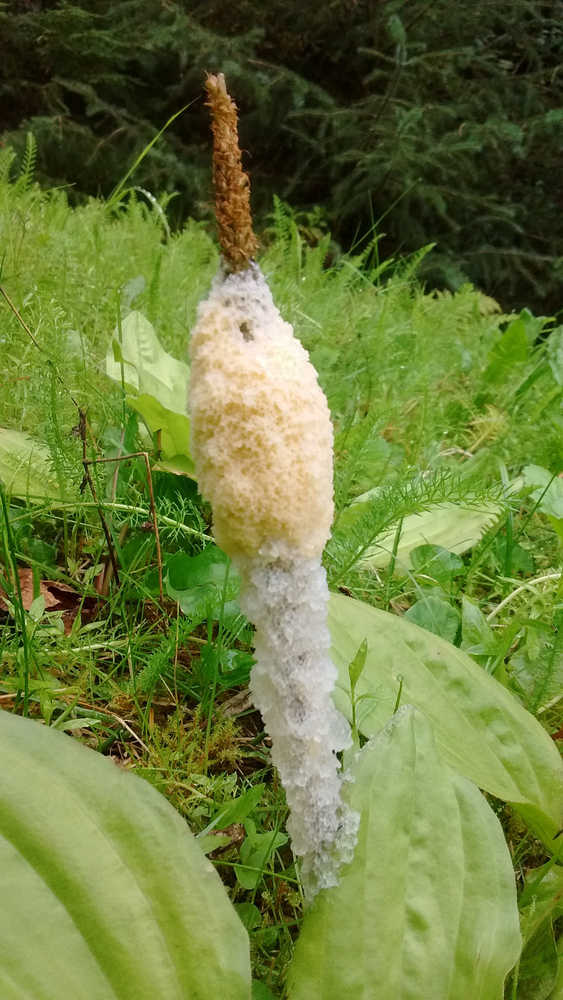Some friends and I find it endlessly entertaining to take a walk and just see what we can see. Sometimes our curiosity raises more questions than it answers, but that is OK. Here are a few examples from various walks in August.
In Amalga Meadow we happened to notice some odd-looking alder cones. Well-developed green cones sometimes have brown areas from some unknown affliction, but these had dark, wrinkled, strap-like things, almost half an inch long, sticking out of the sides of the cones. What could that be? Looking for a clue, I took a specimen to the helpful forest pathologists at the Forestry Sciences Lab, who quickly provided an answer. It’s the alder tongue gall (Taphrina alni), a parasitic fungus known from other parts of the world but not, apparently, from the western U.S. except for Alaska. Other members of this genus infect cottonwoods and aspens.
Many of the muskegs are dotted with the fruiting stalks of the little white swamp gentian (Gentiana douglasiana). Each stalk bears a few yellow cup-like structures that look superficially rather like flowers. But they are only the remnants of the flowers — the white petals are long gone, leaving just the calyx, which backed up the petals. In each small calyx cup lie several round seeds. This looks very much like a seed-dispersal mechanism I did not mention in my recent essay on that topic. It seems to be what is called a ‘splash-cup’ — a rain drop hitting the cup could splash out the seeds. (Bird’s nest fungi disperse spores this way, too).
A walk in some Eaglecrest meadows turned into a blueberry-sampling trip. We have two species of low-bush blueberries (Vaccinium caespitosum and V. uliginosum), and both bore good crops of berries. (I omit the common names, because those differ according to what book you consult, and it only gets confusing.) Some harvesters thinks that V. caespitosum has better flavor than V. uliginosum, but our moderately extensive taste-testing on this day at Eaglecrest revealed that there can be a lot of overlap in flavor: some V. uliginosum are just as tasty as many V. caespitosum, and some tasters actually prefer them. I bet that both species make good jam.
As we walked down the road after sampling berries, we heard a hawk call behind us. I spun around, initially thinking that I’d spot a red-tailed hawk. But I quickly realized that I’d heard what we jokingly call the ‘blue red-tail’ — a Steller’s jay mimicking the hawk’s call. They do it quite well.
Out at the Boy Scout beach area, erosion of the bank where the trail comes to the beach has progressed; it is now safer to walk through the spruce grove than to teeter along a crumbling ledge. We walked across what I call the Goose Flats, between the camp trail and the beach berms. No geese were visible, but at the south end of the flats a flock of geese suddenly all raised their heads above the grasses. Ooops, did not mean to disturb them. So we veered off toward the berm. In a few minutes, most of the heads were back down, foraging once more, and only two sentinels had raised heads. Shortly thereafter, all heads were down again, and we cruised out to the beach without further disturbance to them.
The expansive stands of fireweed put on a splendid show of red foliage and clouds of white-parachuted seeds ready to fly on a breeze. The last of the strawberry flowers were visited actively by hoverflies, but surely it was too late for berries to develop.
There are some rather funky little ferns called moonworts (formerly classified as species of Botrychium but now split into several genera), which do not look like ordinary ferns. A common species puts up a leaf with several fleshy, leathery, rough leaflets and a stalk bearing clusters of spore capsules. I have seen these in Gustavus and Glacier Bay, growing in sandy soils behind storm berms and on upper beaches and outwash meadows, but (so far) I have not found them in Juneau. The Alaska expert on this group of ferns has found them in the Eagle Beach area, so I will keep looking.
Moonworts have not been studied as much as some of the ‘ordinary’ ferns, but here are a few tidbits: The small, underground gametophytes (see my essay from two weeks ago) have mycorrhizal fungus connections to surrounding plants, drawing in nutrients. At least in some species, the gametophyte is persistent (unusual in most ferns) and can be quite long-lived, supporting the sporophyte as it grows and even after it has matured. Some species can live over a dozen years, but others have shorter lives. Many are capable of prolonged dormancy, going ‘to sleep’ for a year or more before appearing again above ground. Inbreeding is possible and sometimes very common, when the gametophyte is both male and female. They seem to like sunshine better than shade and often grow on disturbed sites.
Slime molds are always interesting, if mysterious. As I have noted in previous essays, they spend their lives as separate cells, living independently in soil and litter. Then some magical signal goes out, and the scattered cells migrate to form big clumps composed of millions of individual cells. This is the opportunity for reproduction, but only some of the aggregation does so. Near the road down from Salmon Creek Dam, we found a fine specimen that didn’t just sprawl over the grass and moss; it climbed the seeding stalk of a plantain. The uppermost part of the aggregation had differentiated, so it looked distinctive; this may have been the part that was producing spores for dispersal.
Thanks to Drs. Paul Hennon and Robin Mulvey, Forestry Sciences Lab, for their customary amiable help, and to Dr. Mary Stensvold, U.S. Forest Service in Sitka, for helpful instruction on moonworts.

